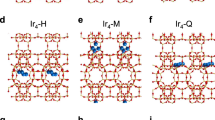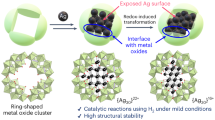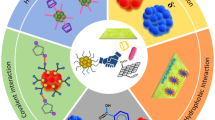Abstract
The integration of metal atoms and clusters in well-defined dielectric cavities is a powerful strategy to impart new properties to them that depend on the size and geometry of the confined space as well as on metal–host electrostatic interactions. Here, we unravel the dependence of the electronic properties of metal clusters on space confinement by studying the ionization potential of silver clusters embedded in four different zeolite environments over a range of silver concentrations. Extensive characterization reveals a strong influence of silver loading and host environment on the cluster ionization potential, which is also correlated to the cluster’s optical and structural properties. Through fine-tuning of the zeolite host environment, we demonstrate photoluminescence quantum yields approaching unity. This work extends our understanding of structure–property relationships of small metal clusters and applies this understanding to develop highly photoluminescent materials with potential applications in optoelectronics and bioimaging.
This is a preview of subscription content, access via your institution
Access options
Subscribe to this journal
Receive 12 print issues and online access
$259.00 per year
only $21.58 per issue
Buy this article
- Purchase on Springer Link
- Instant access to full article PDF
Prices may be subject to local taxes which are calculated during checkout





Similar content being viewed by others
References
Martens, J. A. et al. NOx abatement in exhaust from lean-burn combustion engines by reduction of NO2 over silver-containing zeolite catalysts. Angew. Chem. Int. Ed. 37, 1901–1903 (1998).
Vosch, T. et al. Strongly emissive individual DNA-encapsulated Ag nanoclusters as single-molecule fluorophores. Proc. Natl Acad. Sci. USA 104, 12616–12621 (2007).
Richards, C. I. et al. Oligonucleotide-stabilized Ag nanocluster fluorophores. J. Am. Chem. Soc. 130, 5038–5039 (2008).
Henglein, A. Small-particle research—physicochemical properties of extremely small colloidal metal and semiconductor particles. Chem. Rev. 89, 1861–1873 (1989).
Mulvaney, P. & Henglein, A. Long-lived nonmetallic silver clusters in aqueous solution—a pulse-radiolysis study of their formation. J. Phys. Chem. 94, 4182–4188 (1990).
Diez, I. et al. Blue, green and red emissive silver nanoclusters formed in organic solvents. Nanoscale 4, 4434–4437 (2012).
Yu, J., Patel, S. A. & Dickson, R. M. In vitro and intracellular production of peptide-encapsulated fluorescent silver nanoclusters. Angew. Chem. 119, 2074–2076 (2007).
Borsella, E. et al. Synthesis of silver clusters in silica-based glasses for optoelectronics applications. J. Non-Cryst. Solids 245, 122–128 (1999).
Shestakov, M. V. et al. Lead silicate glass SiO2–PbF2 doped with luminescent Ag nanoclusters of a fixed site. RSC Adv. 4, 20699–20703 (2014).
Coutino-Gonzalez, E. Determination and optimization of the luminescence external quantum efficiency of silver-clusters zeolite composites. J. Phys. Chem. C 117, 6998–7004 (2013).
Grobet, P. J. & Schoonheydt, R. A. ESR on silver clusters in zeolite A. Surf. Sci. 156, 893–898 (1985).
Seifert, R., Kunzmann, A. & Calzaferri, G. The yellow color of silver-containing zeolite A. Angew. Chem. Int. Ed. 37, 1521–1524 (1998).
Wasowicz, T. & Michalik, J. Reactions of silver atoms and clusters in Ag-NaA zeolites. Radiat. Phys. Chem. 37, 427–432 (1991).
De Cremer, G. et al. Characterization of fluorescence in heat-treated silver-exchanged zeolites. J. Am. Chem. Soc. 131, 3049–3056 (2009).
De Cremer, G. et al. In situ observation of the emission characteristics of zeolite-hosted silver species during heat treatment. Chem. Phys. Chem. 11, 1627–1631 (2010).
Gellens, L. R., Mortier, W. J., Lissillour, R. & Lebeuze, A. Electronic-structure of the silver clusters in zeolites of type A and the faujasite type by molecular-orbital calculations. J. Phys. Chem. 86, 2509–2516 (1982).
Gellens, L. R., Mortier, W. J., Schoonheydt, R. A. & Uytterhoeven, J. B. The nature of the charged silver clusters in dehydrated zeolites of type A. J. Phys. Chem. 85, 2783–2788 (1981).
Gellens, L. R., Mortier, W. J. & Uytterhoeven, J. B. On the nature of the charged silver clusters in zeolites of type A, type X and type Y. Zeolites 1, 11–18 (1981).
Sun, T. & Seff, K. Silver clusters and chemistry in zeolites. Chem. Rev. 94, 857–870 (1994).
Fonseca, A. M. & Neves, I. C. Study of silver species stabilized in different microporous zeolites. Micropor. Mesopor. Mater. 181, 83–87 (2013).
Gaarenstroom, S. W. & Winograd, N. Initial and final-state effects in ESCA spectra of cadmium and silver oxides. J. Chem. Phys. 67, 3500–3506 (1977).
Mayoral, A., Carey, T., Anderson, P. A., Lubk, A. & Diaz, I. Atomic resolution analysis of silver ion-exchanged zeolite A. Angew. Chem. Int. Ed. 50, 11230–11233 (2011).
Anson, A., Maham, Y., Lin, C. C. H., Kuznicki, T. M. & Kuznicki, S. M. XPS characterization of silver exchanged ETS-10 and mordenite molecular sieves. J. Nanosci. Nanotechnol. 9, 3134–3137 (2009).
Blake, N. & Stucky, G. Alkali-metal clusters as prototypes for electron solvation in zeolites. J. Incl. Phenom. Macrocycl. Chem. 21, 299–324 (1995).
Kasai, P. H. Electron spin resonance studies of γ- and X-ray-irradiated zeolites. J. Chem. Phys. 43, 3322–3327 (1965).
Foster, P. J., Leckenby, R. E. & Robbins, E. J. The ionization potentials of clustered alkali metal atoms. J. Phys. B 2, 478–483 (1969).
Honea, E. C., Homer, M. L., Persson, J. L. & Whetten, R. L. Generation and photoionization of cold Nan clusters—n to 200. Chem. Phys. Lett. 171, 147–154 (1990).
Onwuagba, B. N. Ionization potentials in alkali-metal clusters. Nuovo Cimento D 13, 415–421 (1991).
Martins, J. L., Buttet, J. & Car, R. Equilibrium geometries and electronic-structures of small sodium clusters. Phys. Rev. Lett. 53, 655–658 (1984).
Kaye, G. W. C. & Laby, T. H. Tables of Physical and Chemical Constants 16th edn (Longman, 1995).
Jackschath, C., Rabin, I. & Schulze, W. Electron impact ionization of silver clusters Agn, n ≤ 36. Z. Phys. D 22, 517–520 (1992).
Kuznetsov, A. S., Tikhomirov, V. K., Shestakov, M. V. & Moshchalkov, V. V. Ag nanocluster functionalized glasses for efficient photonic conversion in light sources, solar cells and flexible screen monitors. Nanoscale 5, 10065–10075 (2013).
Choi, S., Dickson, R. M. & Yu, J. H. Developing luminescent silver nanodots for biological applications. Chem. Soc. Rev. 41, 1867–1891 (2012).
De Cremer, G. et al. Optical encoding of silver zeolite microcarriers. Adv. Mater. 22, 957–960 (2010).
Devaux, A. et al. Self-absorption and luminescence quantum yields of dye-zeolite L composites. J. Phys. Chem. C 117, 23034–23047 (2013).
Neidig, M. L. et al. Ag K-edge EXAFS analysis of DNA-templated fluorescent silver nanoclusters: insight into the structural origins of emission tuning by DNA sequence variations. J. Am. Chem. Soc. 133, 11837–11839 (2011).
Yamamoto, T., Takenaka, S., Tanaka, T. & Baba, T. Stability of silver cluster in zeolite A and Y catalysts. J. Phys. Conf. Ser. 190, 012171 (2009).
Gellens, L. R., Mortier, W. J. & Uytterhoeven, J. B. Oxidation and reduction of silver in zeolite Y—a structural study. Zeolites 1, 85–90 (1981).
Smith, J. V. Molecular Sieve Zeolites-I Vol. 101 (American Chemical Society, 1974).
Mortier, W. J. & Schoonheydt, R. A. Surface and solid-state chemistry of zeolites. Prog. Solid State Chem. 16, 1–125 (1985).
Freeman, D. C. & Stamires, D. N. Electrical conductivity of synthetic crystalline zeolites. J. Chem. Phys. 35, 799–806 (1961).
Simon, U. & Franke, M. E. Electrical properties of nanoscaled host/guest compounds. Micropor. Mesopor. Mater. 41, 1–36 (2000).
Kalogeras, I. M. & Vassilikou-Dova, A. Electrical properties of zeolitic catalysts. Defect Diffus. Forum 164, 1–36 (1998).
Awala, H. et al. Template-free nanosized faujasite-type zeolites. Nature Mater. 14, 447–451 (2015).
Corma, A. et al. Exceptional oxidation activity with size-controlled supported gold clusters of low atomicity. Nature Chem. 5, 775–781 (2013).
Ng, E.-P., Chateigner, D., Bein, T., Valtchev, V. & Mintova, S. Capturing ultrasmall EMT zeolite from template-free systems. Science 335, 70–73 (2012).
Coutino-Gonzalez, E. et al. Thermally activated LTA(Li)-Ag zeolites with water-responsive photoluminescence properties. J. Mater. Chem. C 3, 11857–11867 (2015).
Leyre, S. et al. Absolute determination of photoluminescence quantum efficiency using an integrating sphere setup. Rev. Sci. Instrum. 85, 23115–23115 (2014).
Borsboom, M. et al. The Dutch-Belgian beamline at the ESRF. J. Synchrotron Radiat. 5, 518–520 (1998).
d’Acapito, F., Trapananti, A., Torrengo, S. & Mobilio, S. X-ray absorption spectroscopy: the Italian beamline GILDA of the ESRF. Not. Neutron. Luce di Sincrotrone 19, 14–23 (2014).
Acknowledgements
This work was financially supported by the EC through the project FP7-NMP-2012 SACS (GA-310651), the ERC projects SUPRAFUNCTION (GA-257305), LIGHT (GA-307523) and FLUOROCODE (GA-291593), the Marie-Curie projects ITN-iSwitch (GA No. 642196) and IEF-MULTITUDES (PIEF-GA-2012-326666), the Agence Nationale de la Recherche through the LabEx project Chemistry of Complex Systems (ANR-10-LABX-0026_CSC), the International Center for Frontier Research in Chemistry (icFRC), the ‘Fonds voor Wetenschappelijk Onderzoek FWO’ (G0990.11, G.0197.11, G.0962.13, G.0B39.15), the Flemish government (long-term structural funding-Methusalem grant CASAS METH/08/04 and ‘Configuration of Active Surfaces by Self-Assembly (CASAS2)’, METH/14/04), the Flemish ‘Strategisch Initiatief Materialen’ SoPPoM programme, the KU Leuven Research Fund (IDO/07/011), the Hercules foundation (HER/08/21), and the Belgian Federal Science Policy Office (IAP-VI/27). The experiments 26-01-865 and CH-4207 were performed on the DUBBLE-BM26A and GILDA-BM08 beamlines respectively of The European Synchrotron (ESRF), Grenoble, France. Access to DUBBLE was arranged through the general support of the Fund for Scientific Research-Flanders (FWO) for the use of central facilities. The authors thank the staff of the DUBBLE-BM26A and GILDA-BM08 beamlines (ESRF) for their assistance and technical support. We would like to thank UOP Antwerpen for their donation of the 3A, 4A and FAUX zeolites. O.F. is a Royal Society University Research Fellow.
Author information
Authors and Affiliations
Contributions
P.S., M.R. and J.H. conceived the experiments. O.F., F.R. and S.B. conducted the photoelectron spectroscopy experiments. E.C.-G. and W.B. prepared the Ag–zeolites and conducted the optical characterization. P.L., D.G. and E.C.-G. performed the EXAFS measurements and analysis. D.D.V. and E.C.-G. performed the ESR measurements and analysis. O.F. and P.S. prepared the manuscript with contributions from all co-authors.
Corresponding authors
Ethics declarations
Competing interests
The authors declare no competing financial interests.
Supplementary information
Supplementary Information
Supplementary Information (PDF 2160 kb)
Rights and permissions
About this article
Cite this article
Fenwick, O., Coutiño-Gonzalez, E., Grandjean, D. et al. Tuning the energetics and tailoring the optical properties of silver clusters confined in zeolites. Nature Mater 15, 1017–1022 (2016). https://doi.org/10.1038/nmat4652
Received:
Accepted:
Published:
Issue Date:
DOI: https://doi.org/10.1038/nmat4652
This article is cited by
-
Suppression of kernel vibrations by layer-by-layer ligand engineering boosts photoluminescence efficiency of gold nanoclusters
Nature Communications (2023)
-
Alkynyl-anchored silver nanoclusters in lanthanide metal-organic framework for luminescent thermometer and CO2 cycloaddition
Nano Research (2023)
-
Emerging applications of zeolites in catalysis, separation and host–guest assembly
Nature Reviews Materials (2021)
-
Identification of the active sites in supported subnanometric metal catalysts
Nature Catalysis (2021)
-
Evolution of all-carboxylate-protected superatomic Ag clusters confined in Ti-organic cages
Nano Research (2021)



